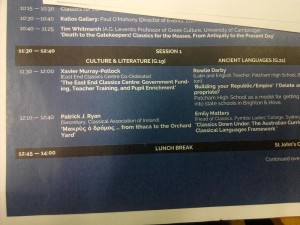
The annual Classical Association conference ascends to Scotland this year. The city of Edinburgh plays host to delegates from around the country and beyond. Beginning a series of posts, this blog post will give an overview of the city.
Arriving at the conference
The city is served by an international airport and lies on major road and rail arteries along the East Coast. The conference takes place at the John McIntyre Conference Centre (19 Holyrood Park Road, EH16 5AY). The official accomodations are sited around the centre.
From Edinburgh International Airport you could probably take the cab to the conference centre. Otherwise, the Airlink Bus (£7.50 open return) or the tram (£8 open return) will get you to Edinburgh’s Waverley station for connecting buses (see below).
From Edinburgh Waverley Station, you will need to locate bus stop code “NC”, which is located on North Bridge (a bridge because it crosses the railway station from above). The bridge has the Balmoral Hotel and The Scotsman on either end.
From Edinburgh Bus Station, it is best to walk through St James Shopping Centre to Princes Street and locate the North Bridge (which crosses over the station from next to the Balmoral). The North Bridge is a road bridge and on the bridge is bus stop NC. From there, follow the above instructions.
At bus stop NC, take southbound buses 14 (towards Greendykes), 30 (Musselburgh) or 33 (Gorebridge). Alight at the Royal Commonwealth Pools. Where you alight is adjacent from the pool. The area behind the pool is the conference area and, at this point, you should follow direction signs.
Getting around Edinburgh
The main bus company for the city is Lothian Bus (http://lothianbuses.com). One-way tickets within the city cost £1.50 whereas a day ticket costs £4. Please note that buses do not give change.
The Sights
Edinburgh cannot be seen in a day. So let me give you a top 3.
1. The Royal Mile
In reality, just walking down the Royal Mile will take a day if you wish to take in all that it can offer.
Begin from Edinburgh Castle. The entry to the castle is where the Edinburgh Royal Military Tattoo festival is based. The castle is imposing and impressive, with great view over Edinburgh. It warrants at least half a day of visit.
Near the mid-point of the Royal Mile is the High Kirk. At this point of the Royal Mile the pedestrianised street is surrounded by period buildings. In mid-August, the Edinburgh Festival Fringe gives it a carnival atmosphere.
At the very bottom end of the Royal Mile is lovely parkland. It is also the site of Holyrood House, a palace for the Stuarts. Opposite the royal seat is the democratic seat, the Santaigo Calatrava-designed Scottish Parliament, with its fascinating lines and wood paneling. Above the two seats is Arthur’s Seat, an extinct volcano that you go up to watch sunrise. By the time you have done the whole of the Royal Mile though, it would take a energetic man to climb the mountain as well.
2. Calton Hill
But if you do have energy left, go under the railway bridge at Holyrood House and head up Calton Hill.
Edinburgh is often known as the Athens of the North. From the Hill you can see replica of the ancient Greek buildings, though only half-built. The Hill also plays host to various monuments for the Scottish Nation and a reminder of the times of the Scottish enlightenment where the Scots seek to have their own identity in the British Nation. This was much later followed by a call for devolution which culminated in the new National Parliament at Holyrood.
3. Edinburgh New Town
Down from Calton Hill, instead of hitting upon the newly-tramwayed Princes Street, strike into the midst of the New Town and head along George Street. The Georgian New Town was built on the opposite side from the Old Town along Royal Mile as the capital of Scotland expanded. The regular street-patterns of the town makes an orderly contrast to the Old Town; the streets have fairly uniform fronts and neat walkways. It is very easy to get lost in it all.
There are many more things to see in the Scottish capital, in particular some outstanding museums of international fame. I hope you get to have a chance to see a snippet of it away from the conference.




